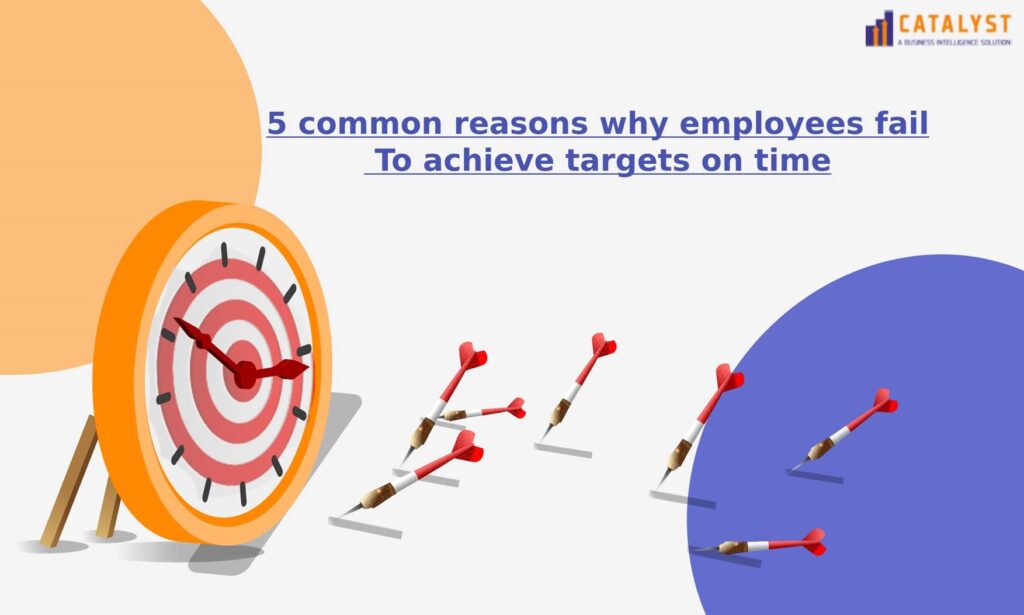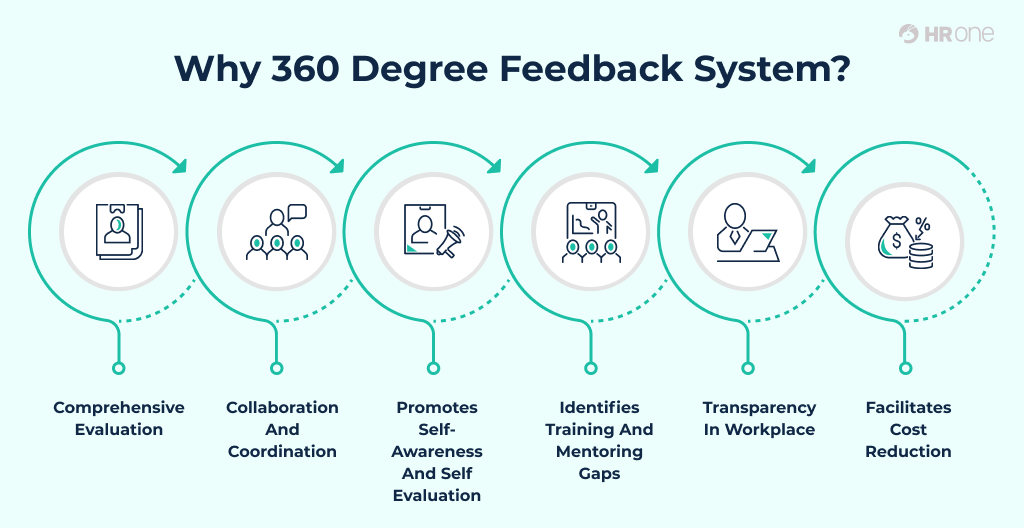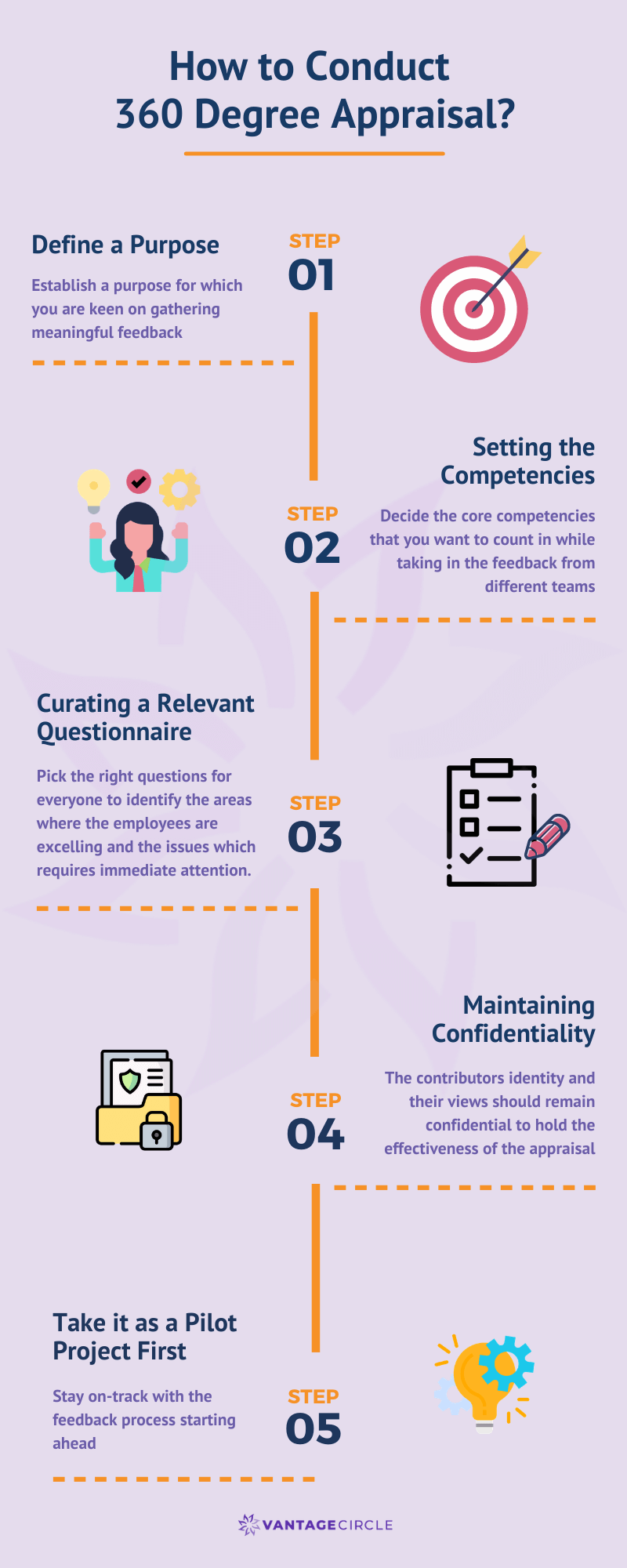
A Complete Guide to 360-Degree Performance Appraisal
Organizations are constantly seeking ways to enhance employee performance and development. One method that has gained widespread recognition for its effectiveness is the 360-degree performance appraisal. In this comprehensive guide, we will delve into the workings of 360-degree performance appraisal, exploring what it is, why it matters, and how to implement it successfully within your organization. Whether you’re an HR professional, a manager, or an employee, this guide will provide valuable insights into this powerful tool for personal and organizational growth.
Understanding 360-degree Performance Appraisal
The concept of a 360-degree performance appraisal, also known as multi-rater feedback, revolves around collecting feedback from various sources, including supervisors, peers, subordinates, and even self-assessments. Unlike traditional performance appraisals , which often rely solely on a manager’s perspective, 360-degree feedback offers a more holistic view of an individual’s performance. This 360-degree approach enables organizations to identify strengths and areas for improvement more accurately.
Why 360-Degree Appraisal Matters
360-degree performance appraisals offer several key benefits:
Comprehensive Feedback: By incorporating input from multiple perspectives, 360-degree appraisals provide a more complete and balanced view of an employee’s performance, helping to identify blind spots and areas for growth.
Development Opportunities: The feedback gathered can be used to tailor individual development plans, fostering continuous improvement and skill enhancement.
Enhanced Self-Awareness: Employees gain valuable insights into their strengths and weaknesses, promoting self-awareness and personal growth.
Improved Team Dynamics: When used for team members, 360-degree appraisals can help in fostering better collaboration and teamwork by addressing interpersonal issues constructively.
Implementing a Successful 360-Degree Appraisal Process
To ensure a successful 360-degree appraisal process, consider the following steps:
1. Clear Communication: Start by communicating the purpose and process of the appraisal clearly to all participants. Transparency is key to gaining trust and commitment from employees.
2. Select Appropriate Ratifiers: Carefully choose the individuals who will provide feedback. Ensure they have sufficient knowledge of the appraisee’s work and can provide constructive, objective feedback.
3. Design a Customized Questionnaire: Create a questionnaire that aligns with your organization’s goals and the specific competencies you want to evaluate. Questions should be clear, relevant, and easy to understand.
4. Anonymous Feedback: To encourage honesty and openness, assure participants that their responses will remain anonymous. This allows for candid feedback without fear of reprisal.
5. Data Collection: Collect feedback from the chosen ratifiers, including supervisors, peers, subordinates, and self-assessments. Utilize an efficient data collection system to streamline the process.
6. Data Analysis: Analyze the feedback data systematically, identifying patterns, trends, and areas for improvement. Focus on both strengths to celebrate and areas that require development.
7. Feedback Sessions: Organize feedback sessions between managers and employees, facilitating constructive discussions about the appraisal results. Encourage goal setting for improvement.
8. Action Plans: Develop actionable plans based on the feedback received. These plans should include specific goals, timelines, and resources required for improvement.
9. Follow-Up: Regularly review progress and provide ongoing support to help employees meet their development goals. This demonstrates your commitment to their growth.
A 360-Degree Appraisal Checklist
To help you get started with your 360-degree appraisal process, here’s a handy checklist:
- Define clear objectives and goals for the appraisal .
- Select appropriate ratifiers for each employee.
- Create a customized feedback questionnaire.
- Ensure anonymity and confidentiality in the feedback process.
- Implement a user-friendly data collection system.
- Analyze feedback data comprehensively.
- Conduct feedback sessions with employees.
- Collaboratively set development goals.
- Monitor progress and provide support as needed.
Now that you have a solid understanding of 360-degree performance appraisal and the steps involved in its successful implementation, it’s time to introduce you to CATALYST – the cutting-edge performance management solution that can simplify and streamline this process for your organization.
Experience the Future with CATALYST
CATALYST is a revolutionary digital performance management system designed to transform the way you conduct 360-degree performance appraisals. With CATALYST, you can say goodbye to cumbersome paperwork and manual data collection. Here’s how CATALYST can benefit your organization:
Efficient Data Collection: CATALYST simplifies the data collection process, making it easy for ratifiers to provide feedback through familiar communication platforms like WhatsApp. This user-friendly approach ensures prompt and hassle-free participation.
Real-Time Tracking: Say goodbye to waiting for feedback reports. CATALYST offers real-time tracking of performance metrics, providing an up-to-date picture of achievements. This dynamic approach eliminates the need for manual calculations and enhances the accuracy of evaluations.
Impartial Evaluation: CATALYST ensures impartiality by relying on measurable goals and minimizing the intrusion of biases . This fosters an environment of trust and fairness, making the appraisal process more reliable and objective.
Holistic Performance Management: CATALYST goes beyond appraisals. It seamlessly integrates with modules like succession planning, Individual Development Plans (IDP), Performance Improvement Plans (PIP), and the 9-box grid, aligning performance management with broader talent management strategies.
Don’t miss the opportunity to revolutionize your performance appraisal process with CATALYST. Contact us today to schedule a demo and take the first step towards a more efficient and effective approach to performance management. Your team and your organization will thank you for it. Embrace the future of performance appraisal with CATALYST.
Related Posts

5 common reasons why employees fail to achieve targets on time

Setting and Measuring Performance-Oriented Professional Development Goals
Just one more step to your free trial.
.surveysparrow.com
Already using SurveySparrow? Login
By clicking on "Get Started", I agree to the Privacy Policy and Terms of Service .
This site is protected by reCAPTCHA and the Google Privacy Policy and Terms of Service apply.
Enterprise Survey Software
Enterprise Survey Software to thrive in your business ecosystem
NPS Software
Turn customers into promoters
Offline Survey
Real-time data collection, on the move. Go internet-independent.
360 Assessment
Conduct omnidirectional employee assessments. Increase productivity, grow together.
Reputation Management
Turn your existing customers into raving promoters by monitoring online reviews.
Ticket Management
Build loyalty and advocacy by delivering personalized support experiences that matter.
Chatbot for Website
Collect feedback smartly from your website visitors with the engaging Chatbot for website.
Swift, easy, secure. Scalable for your organization.
Executive Dashboard
Customer journey map, craft beautiful surveys, share surveys, gain rich insights, recurring surveys, white label surveys, embedded surveys, conversational forms, mobile-first surveys, audience management, smart surveys, video surveys, secure surveys, api, webhooks, integrations, survey themes, accept payments, custom workflows, all features, customer experience, employee experience, product experience, marketing experience, sales experience, hospitality & travel, market research, saas startup programs, wall of love, success stories, sparrowcast, nps benchmarks, learning centre, apps & integrations.
Our surveys come with superpowers ⚡
Blog Employee Experience
360 Degree Appraisal Format: 9 Types + How to Use Them
Parvathi vijayamohan.
29 November 2023
Table Of Contents
To conduct successful 360 degree appraisals for your firm, you need a 360 degree appraisal format. But to know what to ask, you need to know when to ask it.
In this blog we will:
- Define a 360 appraisal format
- Explore 9 types of 360 feedback formats
- Understand how to present this data using 360 appraisal reports
- Answer common FAQs about 360 degree appraisals
What is a 360 degree appraisal format?
A 360 degree performance appraisal combines anonymous, direct feedback from the employee’s self-evaluation, manager, team members and direct reports. This feedback rates an employee on their performance in areas that are vital for the company – like leadership, communication, tech skills, integrity and so on.
The resulting report provides a more comprehensive view of the employee’s skills, strengths and weaknesses compared to feedback from a single source.
Related: 360 Performance Review: Everything You Need to Know
Types of 360 appraisal formats
- For employees
- For managers
- Culture assessment
- Open-ended assessment
- Problem solving competency
- Interpersonal skills
- Communication skills
- Leadership team
Employee 360 appraisal format
Scenario: When you want to evaluate your staff on their leadership skills, communication and more.
What this format does: Employee 360° review templates help you learn more about your employees, especially from perspectives that usually go unheard. You can also customize the form to measure values that are central to your work culture.
Manager 360 appraisal format
Scenario: A comprehensive evaluation of managers by staff.
What this format does: According to a recent survey by Gartner , developing managers to be more visible, empathetic, and connected are a top priority for 60% of HR leaders. So this 360 survey format can be quite helpful for discovering the kind of training your leadership needs.
360 culture assessment format
Scenario: Gauging how much an employee feels like they belong within the company culture.
What this format does: The team is the subatomic unit where culture lives, thrives or dies. This anonymous, peer-review format helps you get honest feedback on whether your employees feel like they belong with the current culture – and what you can do about it.
360 degree appraisal format for open ended feedback
Scenario: Capturing more nuanced insights like feelings, opinions and sentiments.
What this format does: While opinion scales are good for keeping score, open-ended feedback can deliver new, often unexpected insights about your workforce. Moreover, open-ended feedback in the form of comments and examples act as evidence to support the ratings. This 360 degree feedback format allows you to structure your appraisal form as a series of open ended questions.
360 assessment for problem solving competency
Scenario: Assess an employee’s capability for critical thinking and problem solving.
What this format does: There are many components to problem solving . But like all skills, they can be learned with a little bit of training and practice. So if problem solving is a do-or-die skill for your business, then this 360 questionnaire helps you measure this competency in a more detailed way.
360 survey for interpersonal skills
Scenario: Determine an employee’s people skills – how well they interact and work with others.
What this format does: Did you know that there are at least 20 people skills you need to succeed at work? While these may be summed up as ‘empathy’, ‘likeability’, etc., this 360 feedback format lets employees objectively rate their peer on these interpersonal skills, and others as well.
360 survey for communication skills
Scenario: Gauging how effective an employee is at communication.
What this format does: Google “communication skills” and you’ll be deluged with articles, blogs and videos talking about the types of communication you need to succeed in the workplace. This 360 degree survey format is based on peer reviews, and helps you drill down into the specifics of what makes an employee an effective communicator.
360 degree appraisal format for sales teams
Scenario: When sales managers want to drive behavioral change within their teams.
What this format does: The peer reviews from these 360 surveys can also help you recognize issues that are collectively affecting your sales team. It also helps you assess how well you are implementing your sales training and highlights how your sales workflows are going.
360 degree appraisal format for leadership
Scenario: Measuring key leadership behaviors for a successful business performance.
What this format does: A leader’s effectiveness is based not just on their job skills, but also on their soft skills such as communication, empathy, negotiation and body language. This 360 appraisal format gives your leaders better insights into how they are perceived – including the strong points and blind spots in their leadership style.
Keen to get started? You can start with one of our readymade 360 feedback forms and customize it with SurveySparrow to create the best 360 degree appraisal format for your needs.
Please enter a valid Email ID.
14-Day Free Trial • No Credit Card Required • No Strings Attached
How do you write a 360 feedback report?
The reviews are done and the data is ready. Now, how do you go about creating 360 reports for all of the participants?
- Start with a clear introduction that explains the purpose and objectives of the report. This should set the stage for the rest of the report.
- Include a summary of the feedback, highlighting key strengths and areas for improvement. This should be based on the data collected from multiple sources, such as colleagues, managers, and subordinates.
- Use specific examples or comments to support the feedback given. This helps to bring the feedback to life and makes it more meaningful.
- Organize the report into sections, with each section focusing on a specific competency or behavior. This helps to structure the feedback and makes it easier to digest.
- Provide actionable recommendations for improvement. This should be based on the feedback given, with specific suggestions for how the individual can develop their skills and behaviors.
- Conclude with a summary of the key points of the report, and an overall assessment of the employee’s performance.
Remember to keep the tone positive and constructive, focusing on how the individual can improve rather than just criticizing their performance.
360 degree appraisal format: FAQs
What are the four components of 360 degree appraisal.
A 360 performance appraisal always has four components:
- Self- evaluation
- Manager’s evaluation
- Evaluation by subordinates or direct reports
- Peer evaluation
All of these appraisals are clubbed into one feedback report that outlines the employee’s strengths, weaknesses, hidden strengths, and blind spots. However, depending on the role and organization, it can also include a fifth component: customer feedback.
How do you write a 360 feedback form?
To write a 360 feedback form, follow these steps:
- Start by figuring out what you want to achieve with the feedback. What behaviors or skills do you want to evaluate? Then you can design your feedback form to focus on those specific areas.
- Think about who you want to get feedback from. It could be colleagues, managers, subordinates, or even customers, depending on what you’re trying to assess.
- Write clear, concise 360 review questions that are easy to understand and answer. Try to use simple language and avoid industry jargon.
- Use a mix of open-ended and close-ended questions to get both detailed feedback and specific answers. Consider using rating scales for some questions to make it easier to compare feedback across multiple sources.
- Make sure your feedback form is anonymous to encourage honest responses.
- Test your feedback form with a small group of people to see if there are any issues or areas for improvement.
- Once you’ve collected your feedback, use the data to identify areas for improvement and create an action plan to address any issues.
How do you complete a 360 appraisal?
A 360 degree appraisal is always completed with a meeting between the manager and employee to discuss the feedback. It is structured as an open and honest discussion, and focused on the employee’s needs. The meeting should conclude with a discussion about the next steps to take for the employee’s growth.
How do you structure an appraisal?
360 degree appraisals are usually structured this way:
- Establish the criteria for reviewing each employee.
- Select the evaluators for each employee.
- Set a start date and deadline for the 360 appraisal.
- Formally announce the appraisal process in your internal channels.
- Share the 360 survey. With 360 tools like SurveySparrow, you can choose to make the evaluator’s feedback anonymous.
- For self-evaluation, send the same survey to the employee.
- Enable your managers to have 1:1 meetings with each employee to review the 360 report.
Growth Marketer at SurveySparrow
Fledgling growth marketer. Cloud watcher. Aunty to a naughty beagle.
You Might Also Like
10 best idea management software to look up in 2024, turning survey data into narratives: create storytelling magic with data, capture real-time customer feedback with sms surveys – ultimate guide.
Leave us your email, we wont spam. Promise!
Start your free trial today
No Credit Card Required. 14-Day Free Trial
Request a Demo
Want to learn more about SurveySparrow? We'll be in touch soon!
Great employee experiences start here.
Collect, analyze and act on employee feedback. try our 360 appraisal software for free..
14-Day Free Trial • No Credit card required • 40% more completion rate
Hi there, we use cookies to offer you a better browsing experience and to analyze site traffic. By continuing to use our website, you consent to the use of these cookies. Learn More

- HR Software
Inbox For HR TM
- InboxForHR TM

From Roots to Wings: HROne’s Rebranding Journey
Mobile App
- Integrations

- Payroll Outsourcing
Payroll Outsourcing Services
Reclaim the Peace of Mind you Deserve
From Roots to Wings: HROne’s Rebranding Journey
Recent Reads

Employer Branding Strategies: Attracting candidates with your company culture

Key Components of an Effective Performance Management System

The Application Process: Creating a smooth experience for candidates
Explore Topics
- Performance
New in Guides

Human Resources Management System Guide
Seize the power of cutting-edge insights to revolutionize HR operations and enhance productivity.

Change Management in HR Shared Services: Dealing with Resistance

Navigating the Leadership Landscape to be an Authentic Leader

Leadership Development for Success: Cultivating Authentic and Inspiring Leaders
From Roots to Wings: HROne's Rebranding Journey
Discover the story behind our new brand identity.

HROne PROPEL

HROne PROPEL-Ahmedabad 2024
Fill the form to join in and gain wealth of insights, engage in candid interactions and more.
The CHRO Mindset
New Episode

FUTURE-FORWARD TALENT PLANNING
Building a Culture of Engagement and Future-Forward Talent Planning with Sulbha Rai
HROne Masterclass
Strategic HR Management

Uncover the secrets to aligning HR to business strategy and leveraging HR tech and innovation.
- HR Glossary
Learn about Top HR terms
People Analytics?
Types of leaves
Payslip Template
Appraisal Meaning

Offer Letter Template
Use our send ready template to close positions faste
A Complete Guide to 360 Degree Performance Appraisal [+Checklist]
31 st Oct 2022
6 mins read

Arvind Mishra

Performance appraisals are mostly gut-wrenching news.
According to the latest survey, 22% of employees called in sick, 35% complained to their colleagues, and 15% even cried on their performance appraisals. These numbers sure make us rethink the effectiveness of yearly performance appraisal methods.
Are they worth it? And if not, is the popular 360-degree performance appraisal method good enough? How do we execute it, and what should we take care of so that it doesn’t backfire? That’s a lot of questions. Let’s find answers to them in this blog!

Read the blog to understand:
- What is a 360 Degree Appraisal?
- Objectives of a 360 Degree Performance Appraisal
- Benefits of a 360 Degree Feedback
- Components of a 360 Degree Assessment
- How is a 360 Degree Appraisal Different from a Traditional appraisal?
Advantages of 360 Degree Appraisals
- Types of 360 Degree Appraisals
- How to conduct a 360 Degree Appraisal
- Tips for an effective 360 Degree Performance Appraisal
What Is A 360-degree Appraisal?
A 360-degree assessment is a performance appraisal method that takes feedback and ratings from various sources like supervisors, staff members, peers , co-workers, and customers.
It prefers feedback from as many sources as available than a single source of truth. After collating all the feedback, the manager uses it to gauge the employee’s skills, strengths, and weaknesses.
When implemented correctly, it paints a fairer picture. Thus, boosting team morale and performance. It also promotes employees’ self-awareness and upholds more transparent communication.
Objectives of a 360-degree Performance Appraisal
360-degree feedback, when implemented correctly, can be a massive opportunity for the organization . Its core objectives are as follows:
SWOT Analysis
SWOT analysis, or generally self-awareness, enables employees and leaders to compare their self-ratings to those of others. It helps them paint a fairer picture of themselves. Multi-rater feedback helps perform a SWOT analysis on parameters like:
- Performance in role
- Performance in specific activities
- Capabilities
- Working patterns
- Suitability for a particular task.
Change Management
The 360-degree evaluation drives change very gently when employees and leaders get a clearer picture of their behaviors and competencies. They hardly have any option. They have to change for the better, which drives organizational change.
Decision Making
Another core objective is fairer personnel decisions like performance-related bonuses , promotions, etc.
Alignment of Goals And Potentials
360-degree performance appraisal also enables organizations to align employee aspirations with the company’s goals, values, and vision.
Overall Development
This appraisal process enables the organization to plan holistic employee development, like teamwork, leadership and communication skills, and other soft skills. The organization can align the roadmap of this employee development with organizational needs and values.
Components of a 360-Degree Assessment
- Self-appraisal: It is the part of the process where the employee reflects on his competencies and performance. It includes self-rating and review.
- Superior appraisal: It is similar to a traditional assessment, where the manager or other superior provides ratings and feedback on employee performance.
- Subordinate appraisal: Subordinates often provide feedback on critical performance aspects like motivating abilities, communication skills, leadership qualities, work delegation capabilities, etc.
- Peer review (internal customers) : It provides valuable insights on teamwork, sensitivity towards others, and co-operating behavior.
How is a 360 Degree Appraisal Different From a Traditional Appraisal?

Comprehensive Evaluation
Because the feedback comes from so many resources , it tends to be more accurate. It is easy to recognize patterns from the various feedbacks received. It also sheds light on more abstract aspects which are otherwise hard to measure.
Collaboration and Coordination
A 360-degree evaluation helps both teams and individuals understand their strengths and weaknesses. Thus, equipped with this knowledge, they can collaborate more efficiently and seamlessly.
Promotes Self-Awareness and Self Evaluation
They are better aware of their skills and try to work toward learning new skills and developing existing ones. They can form a connection between how they perceive themselves and how others do.
Identifies Training and Mentoring Gaps
Skill gaps can hinder an organization’s progress. A 360-degree performance appraisal helps identify skill gaps across individuals, teams, departments, and the entire organization.
Transparency in Workplace
This feedback method can increase trust between employees. It can lead to better decision-making, productivity, and knowledge sharing. All of these can help companies tap into unrealized potential.
Facilitates Cost Reduction
Deloitte reports that 58% of companies feel traditional performance methods are not an effective use of time. With the help of suitable performance management software , you can reduce costs and twice your revenue!
Types of 360-degree Appraisals
Employee development.
360-degree appraisal involves anonymous feedback where every employee is comfortable expressing honest feedback, which is impossible face-to-face. Equipped with honest feedback, the employee knows it’s lacking and can take steps to be more effective and efficient.
- Performance Appraisal
This is when the 360-degree appraisal measures professional skills and key performance metrics. Experts do not recommend this version of 360-degree feedback because it mainly measures soft skills and competencies and can introduce the competition factor.
How to Conduct 360-degree Appraisal?

1. Define Purpose
Multi-rater feedback differs from traditional methods because you need to set the purpose of conducting it before starting the process. Your goal could, for example, be:
- Getting an unbiased view from all touchpoints
- Looking out for skill gaps
- Understanding the interoperability level of teams, etc.
2. Choose Competencies
Set the competencies the team members will use to evaluate each other. All the competencies must be relevant to the employee role and the organization’s vision and needs.
3. Curate Questionnaires
Prepare survey questionnaires based on the chosen competencies. The questions must be such that they help identify the gaps and strengths of the team and the individuals.
4. Chalk Out Guidelines
Prepare guidelines, such as who will review whom and how you will maintain the confidentiality of the whole process. Also, you should communicate the entire process to all the employees and managers.
5. Test the Method
Before going all in, test the method as a pilot project. You can try it on a selected subset of employees before rolling it for the entire organization. Study the results and the inefficiencies. Overcome them. And gradually take in the whole company.
A 360-degree feedback appraisal provides a holistic view of the employee. It helps measure hard-to-gauge aspects like leadership and communication skills, sensitivity to others, team spirit, etc. It gives you and the employee a fairer and broader perspective of their capabilities.
Hence, give 360-degree feedback a shot at your organization while keeping all the above points in mind, and you will most likely nail it.
Recent Posts

Employer Branding Strategies: Attracting candidates with your...

Key Components of an Effective Performance Management...

The Application Process: Creating a smooth experience...

Goal Setting through HRMS: Aligning Individual Objectives...

Diversity and Inclusion in Recruitment: Best Practices...

G2's Best Software Products for 2024: HROne...

Using Attendance Data to Improve Workforce Management

Leveraging Social Media for Recruitment: Strategies for...
Arvind Mishra is Director of Delivery & Outsourcing at HROne. He has substantial experience of two decades in HR automation and has successfully delivered complex projects across 20+ industries globally. His work is instrumental in scaling HR tech adoption for companies of every size in India.

When we go shopping, we look for renowned brands because...

An organization is not only a physical infrastructure but is...

In this extremely fast-paced world, no business wants to stay...

Goal Setting through HRMS: Aligning Individual Objectives with Company Goals
What is a life without goals? You will never know...

Diversity and Inclusion in Recruitment: Best Practices for Equitable Hiring
An organization is not only based on how well you...

G2's Best Software Products for 2024: HROne Earns the Top Global Spots
Introduction Hindustan Times has covered the news already. Yes! We’re...
Make your Performance fun and easy!
Learn how HROne Performance can help you automate Performance & stay 100% compliant!
Become Our Partner Today!
By providing your information, you hereby consent to the HROne Cookie Policy and Privacy Policy .
Download Now!
Stay up-to-date with HROne Newsletter!
- Recruitment
- HR Solutions
- Time Tracking
- Payroll Solutions
- HR Professionals
- Team Manager
- Payroll Management
- Employee Engagement
- Performance Management
- Leave Management
- HR Software Gujarat
- HR Software Mumbai
- HR Software Bangalore
- HR Software Delhi
- HR Software Chennai
- HR Software Hyderabad
- Payroll Software Gujarat
- Payroll Software Mumbai
- Payroll Software Bangalore
- Payroll Software Delhi
- Payroll Software Chennai
- Payroll Software Hyderabad
- About HROne
- HROne Commune TM
- ItsCredible
- WhatsApp Bot

Schedule A Demo!
Copyright © 2024. Uneecops Workplace Solutions Pvt. Ltd. All Rights Reserved. | Uneecops Group Company | Privacy Policy | Cookies Policy | T&C

The Guide to 360-Degree Performance Appraisals that Work for You, and Your Employees
360-degree appraisals can change lives, says an essay in the Harvard Business Review . With as many as 90% of Fortune 500 companies using these performance evaluations, there’s good reason to trust in their usefulness. But like most good things in life, there’s a caveat. Badly done 360 reviews can make little difference to employees and the organization—or even make things worse. Evaluating an employee’s performance, then, is clearly tricky. Flexible, holistic appraisals that cover every aspect of an employee’s performance are the need of the hour. Understanding what 360-degree performance appraisals are, and how to get them right, will help you handle that need with finesse.

Working every angle
How much of your daily work is really visible to your team lead? How much of it can be broken down into a simple annual checklist? It’s clear that the feedback that comes from managers once a year just isn’t enough to understand the modern workplace.
360-degree appraisals look to present a broader perspective on performance by focusing on two key areas—who these reviews come from, and what they cover. By incorporating feedback from peers, direct reports, and clients alongside managers’ perspectives, this type of appraisal offers a more balanced view of the employee. This is especially helpful when managers themselves are not directly involved in the day-to-day tasks of an employee.
Further, 360-degree appraisals focus on constructive employee growth, rather than simply pointing out areas they need improvement in. The objective is to open up conversations about employee strengths and weaknesses, the skills that they can leverage, and the training they need to do their job better. Identifying and understanding these factors is where 360-degree performance reviews are particularly useful.
These reviews can also go a long way in helping HR understand the dynamics of their workforce, and how they can work to cultivate the best and brightest talent. However, there are several aspects to consider in implementing this system if you’re to truly reap its benefits.
Company values—a cornerstone of successful reviews
The foundation for a productive 360-degree appraisal system is a company culture that is ready for change. Implementing these appraisals isn’t easy, especially in organizations used to more rigid methods. Building a climate of trust in the workplace is very useful in carrying out effective 360-degree reviews.

An essential ingredient in enabling trust is to uphold the integrity of the leadership of the organization. The people at the top should lead the way through transparency in their communications, decisions, and actions, and commitment to their organizational duties. The presence of a strong unifying mission and vision can also promote a trusting work environment.
These elements coalesce to create a workforce that is ready for 360-degree reviews. Employees are open to providing and receiving feedback to each other, regardless of their role. Management is ready to commit to the process. Everyone is aware of the goals they must work toward. They know how they can work with those around them to achieve these goals.
A simple guide to designing reviews
With a receptive company culture, it’s time to get to the nitty-gritty of the reviews. No two organizations can have the same approach to 360-degree appraisals. Replicating another appraisal system without accounting for the specific characteristics of your organization can easily lead to failure. The responsibility for this groundwork lies with HR.

Establish and define the purpose of 360-degree reviews
What do you hope to accomplish with your appraisals? What are the questions you hope to answer in such a process? Creating a well-defined goal is the critical first step to actually achieving it.
Identify the competency and assessment items
Once you know the ‘why’ of your 360-degree reviews, the focus is on the ‘how’; how can you direct the review to cover what’s most important to your organization? Recognizing key factors that influence employee performance go a long way in setting a comprehensive review agenda. These could include the strength of their skills, valuable core competencies, and their results in key areas.
Construct a feedback plan
Essential to having productive 360-degree appraisals is designing a system that provides useful feedback to participants.
Questions on interactions with other employees and clients, proficiency in their assigned work, and more, form the basis of the feedback itself. These questions in the feedback questionnaire must be precise and relevant to the purpose of the review. Getting useful answers relies on tuning your questionnaires to the specific requirements of your organization, focused on areas like creativity, and leadership and interpersonal skills.
The next stage is choosing how to collect these inputs—through surveys, in-person conversations, or online systems.
Deciding how to deliver feedback is the final stage in the process. Whether through a review meeting, reports, or a combination of methods, this step will determine the benefits of the feedback process.
Appraisals are thus designed to prop up organization-specific performance ideals through a holistic process of identifying and assessing these factors.

Test your appraisals to see how they work
Once you’ve set up a 360-degree appraisal system tailored to your requirements, getting it to run smoothly and productively takes some more effort.
A useful first step in the implementation could be running a pilot process. Opening up the review system to a small number of reliable employees allows honest opinions on what works and what doesn’t. Acting upon this information greatly improves the odds of its success when deployed on a larger scale.
The 3-point guide to implementing appraisals
When the appraisals are ready to go company-wide, you’ll need to make it easy for your employees to get on board. This is where choosing the right 360 system goes a long way. Ideally, it has a simple, structured interface that’s used to gather input and present complex details collected through the reviews. This entire flow must integrate smoothly with your HRMS to ensure a cohesive experience. A confusing appraisal process is self-defeating.

With everything set up, the 360-review process itself comes down to 3 simple steps:
Selecting the reviewers – employees can usually choose their reviewers or raters, although they’re sometimes assigned by HR. Selecting a good number of reviewers who’ve worked closely with the subject across settings is critical to a constructive review.
Carrying out the review – the main review essentially has two steps—sending out the reviews to the employee with notifications and a feasible deadline, and the subject answering the questions in the review. An online review system is particularly helpful here to ensure that the responses can be easily recorded.
Reporting results from the review – reports summarize the information that the reviews have collected, including self appraisals and feedback from the various raters. One way to present these to the subject is directly, through physical or online documents. A more personal approach is a one-on-one review with the employee. The reviewer gives the employee their input on where they could improve, based on the information the reviews came up with.
Work with your employees after the review

According to a popular Forbes essay , one of the main reasons a 360-degree review system fails is the lack of follow-up. No matter how thorough your actual reviews are, they won’t measurably empower your staff until the post-review process is properly carried out.
Your responsibility in HR is to ensure that the employee is putting to practice the suggestions made after the review. There must be an effort towards guiding the employee on the path of personal and professional progress, with room for the occasional failure.
A good way to champion the employee’s growth is to encourage them to set up a personal development plan. Checking in regularly assures the employee you are equally committed to their success. Having follow-up meetings after a couple of months can help track which of their goals they’ve accomplished, and in which they could use your support.
The remodelled appraisal

The key to the success of 360-degree reviews or appraisals is to look at them as a tool to help employees reach their potential. Done right, they can make your workforce a highly motivated group of people who are ready to do whatever it takes to get better—including acknowledging their missteps.

Always reading, always writing. Passionate about digging into the depths of any subject, from technology to philosophy
Leave a Reply Cancel reply
Your email address will not be published. Required fields are marked *
Related Posts
360 Degree Appraisal – A Brief Guide for HRs
In this guide, we will cover:
- What is 360 Degree Appraisal?
- Why 360 Degree Appraisal?
- Conducting 360 Degree Appraisal.
- Advantages of 360 Degree Appraisal.
- Disadvantages of 360 Degree Appraisal
Fill up to download your copy now

What is 360 Degree Performance Appraisal? Methods, Advantages & Disadvantages

You must have already heard about performance management system at enterprises for effective employee management . But do you know the benefits and best methods? Do you know what is 360 degree appraisal?
This blog will help you learn definition of 360 appraisal management and unique methods to perform. Let’s start with definition of 360 degree performance appraisal.
What is 360 Degree Performance Appraisal?
In its simplest, 360 degree performance appraisal is an advanced form of providing appraisals to employees at organisation. It involves feedbacks from different associated groups of organisation and outside (clients). The group of people or reviewers may include manager, HR, colleagues, and client they worked with.
The feedback is collected in the form of reviews from people and provides data for appraisals accordingly based on reviews. In other words, 360 degree appraisal method includes multi source feedbacks for the employees affected by their performance throughout the period.
Also Read: 11 Key Objectives of Performance Appraisal in 2024

Importance of 360 Degree Performance Appraisal
When we talk about business performance and growth, what most important? Definitely your employees, their well-being and what else?
Now, what could be better than feedback appraisal for employees based on their performance? The activity helps motivate your employees to perform better every time. An accurate and fair 360 appraisal system makes employees an important asset in terms of effective employee management at an organization.
360 Degree Appraisal Method
- Rating scale method
- Ranking method
- Free form method
- Confidential reporting method
- BARS method
1. Rating Scale Method
Rating scale is one of the most common methods of assessing an employee’s performance. This method includes a scale of 1 to 10 points. The parameters of the scale rating are delivery, attitude, attendance, regularity, and accountability, which are rated for the employee accordingly.
Many performing companies are using this method to have an effective and simple activity at place. The reviewing people are selected based on the employee’s role and nature of the job. The number of points scored for all the columns are finally added. Employees are therefore recognised and given a raise based on the performance and ratings.
This method makes the 360 degree performance appraisal management easier and fool proof.
2. Ranking Method
This traditional method includes comparison of performance of the employees with other employees at same tier and with same rank. Here a manager is allotted to provide the comparison report based on numbers and graph. A fixed percentage of employees are allotted different performance categories like excellent, good, average, below average, poor etc.
Ranking method is generally used when the manager has to make decision as to which person is the best worker for a given period of time. When someone has to be promoted or needs to be laid off, ranking methods is the best and quick way to rank.
The biggest advantage of this method is that it comes handy to HR manager and makes the complicate reviewing process easier.
3. Free Form Method
It is also called the ‘Essay appraisal method’. This is because the superior provides a detailed description of the selected employee’s performance. This includes supporting documents and examples of his/ her performance. This method could be highly biased at providing feedbacks.
The reviewer under this method also uses the rating scale method (described earlier in the blog) to rate the weaknesses and strengths of an employee to validate the essay report. This method is very time consuming as the reviewer is required to collate all the documents and submit a brief.
Free form method is considered to be one of the non-quantitative evaluations for performance appraisal .
4. Confidential Reporting Method
This method is very popular among governmental organizations. Here the superiors need to write a confidential report on the subordinates, who needs to be reviewed, with respect to his/ her behaviour and duties at organization. The report prepared here would not be exposed to anyone.
This is only referred by the top management or the human resource. In India this method is being used by most of the government organizations like the Armed Forces, Police department, CBI etc. The main factors assessed here are:
- Temperament
- Sincerity and trust-ness
- His/her behaviour with the subordinates
5. BARS Method
BARS (Behaviourally Anchored Rating Scale) method is one of the new age methods to provide accurate feedback. The method consists of a set of behavioural statements that explain the performance of an employee towards a particular job.
This method acquires a set of parameters and decided points for each. The performance parameters could include good, bad, average, must be laid off, and so on.
Also Read: How to Ensure Constructive Feedback for Managers?
360 Degree Performance Appraisal Advantages and Disadvantages
Appraisal management system could be very powerful asset for businesses. Yet, every resource has its own advantage and disadvantage.
Advantages of 360 Degree Appraisal
- Self-development
- Fair and accurate reviews
- Eliminates Biasness
- Motivated workforce
- Comprehensive view of employee performance
- Persuasive Reviews
- Boost employees morale
- Positive work environment
Let us get an insight into the advantages of 360-degree appraisal.
▸Self Development of Employees
The 360-degree appraisal system includes acquiring of 360 degree feedback from different proficient, skilled, and accomplished personnel from the organization. This will give a vivid picture of the areas of improvement for the employees and they can work on it for self-development.
In addition, it helps employees to know the expectancy and standard of performance expected from him and can work accordingly to achieve it.
▸Fair and Accurate Reviews
The 360 degree appraisal reviews are just and fair as the review system includes different departments or different personnel and not a single source.
This surges the transparency of reviews and blocks the loop holes of biasness or unfair reviews. The accuracy of reviewing also escalates.
▸Eliminates Biases
The 360 degree appraisal is bias-free as the 360 degree feedback is a multi-rater feedback system that is appropriated from different sources of an organization and is not monocentric.
The performance review of employees is acquired on the basis of their strengths and weaknesses, skills, and more are evaluated based on the feedback of employers, peers, managers, and more. Overall it is a 360-degree performance management.
so, it leaves no room for biases as biased feedback can be filtered out from the actual ones by referring to the statistics of multisource reviews.
▸Motivated Workforce
One of the vital advantages of the 360-degree appraisals is that it motivates the employees in terms of both resource and knowledge. In terms of resources, an appraisal system adds to the income of an employee which is the main focus of outcome for productivity for an employee.
Similarly, a 360-degree feedback is taken from diversified personnel from the organization which boosts their morale when the reviews are positive and exhibits the areas of learning from the adverse ones.
▸Comprehensive view of Employee performance
The employee’s 360 degree performance is reviewed in a comprehensive way which gives a brief insight into the work process and progress of the employee. A 360 degree appraisal is an outcome of the 360 degree feedback system which is a comprehensive way of gathering reviews from multiple sources within an organization.
It gives a vivid insight into the performance of the employee as well as showcases the areas to improve.
▸Persuasive Reviews
The feedback system in a 360 degree appraisal is comprehensive as it is reviewed by proper reasoning and analytics rather than casual evaluation.
It is not just a merry temptation of biases but rather an analytical review that is a result of the diversified reasoned opinion of various ( employer, peer appraisal feedback, and more) personnel in an organization. Being a multi-rater feedback system, the reviews are not only fair but also persuasive.
▸Boost Employees Morale
The appraisal and positive feedback from heterogenous prominent personnel as well as peers improve the employee’s morale and encourage them to be more productive. In addition, the adverse feedback too increases the learning capacity of the workforce and makes it a win-win situation for them in both scenarios.
Besides, appraisal and recognition naturally boost the employees’ motivation to be more productive.
▸Positive Work Environment
The process of 360-degree feedback contributes to team building by enhancing the professional relationship among the organization’s workforce.
An engaging and healthy professional relationship between the employees yields a positive work environment out of controversies and conflicts.
Also Read: 4 Tricks to set-up a Fair and Transparent Appraisal system!
Disadvantages of a 360-degree appraisal system
There are various pointers that can prove as a disadvantage in a 360-degree appraisal system which includes
- Time-consuming
- Bias and Unfairness
- Data Overload
- Lack of accountability
- Conflicting feedback
- Internal controversies
- Enhances Office politics
Let us take a close watch on the above-mentioned pointers on the disadvantages of 360-degree appraisal.
▸Time Consuming
The process of a 360-degree appraisal is time exhausting as it goes through different personnel in an organization for 360-degree feedback.
The process of gathering feedback, analyzing the received data, discussing the feedback, and appropriate follow-ups take time. The multiple steps and personnel involved in it make it lengthy and time-consuming.
▸Bias and Unfairness
This is a potential drawback that can prevail while giving feedback. Feedback may be influenced by personal relationships, and biases and can be an outcome of office politics.
Specifically, when the company size is mid, office politics becomes prominent. In addition, there is intentional negative feedback in fear of retribution which degrades honesty and transparency in acquiring feedback.
▸Data Overload
360-degree appraisals system gathers feedback from diversified sources like employers, subordinates, peers, and sometimes even customers in order to make it more authentic. But this in contrast increases the data and results in data overload thereby creating complexities and confusion.
In a mid or large-scale company where the employees count is large, 360-degree performance appraisal data creates perplexity and goes puzzled for the management to access.
▸Lack of accountability
The 360-degree appraisals system too has accountability issues as it comes from different sources and makes it difficult to determine who is responsible for specific comments or suggestions.
For example, if an employee receives negative feedback from a peer, it may be difficult to determine who specifically provided the feedback. This can make it challenging to follow up on the feedback and take appropriate action.
▸Conflicting Feedback
As a 360 degree feedback is acquired from various sources, the possibility of contradictory feedback persists which creates confusion.
This not only creates perplexity but also makes it challenging for employees for understanding their priority areas that need attention and focus.
▸Internal Controversies
As there are multiple raters to review the performance of an employee for 360-degree appraisal, There arises conflicts and disagreements between the raters regarding the feedback.
For example, a peer may rate an employee’s performance highly, while a supervisor may rate the same employee’s performance as average. These discrepancies can create internal controversies and make it challenging to develop an accurate assessment of an employee’s performance.
▸Enhancement in Office Politics
In some cases, feedback provided by raters can be misinterpreted, leading to controversies. For example, a rater may provide feedback that is intended to be constructive, but the employee may interpret it as overly critical or negative.
This can create internal conflicts and lead to gossip, hatred, and toxicity giving rise to office politics. It affects the healthy work environment and makes it gloomy.
Committing to performance appraisal on your own without any software assistance could be difficult and error prone. Data handling could be the biggest hurdle. Instead, dedicated software like appraisal management system can help conclude with yearly appraisal skilfully and easily. Pocket HRMS is one such integrated HR solution!
Visit Pocket HRMS to get cloud-based HRMS software today. Also, follow our recent blogs to learn new HR strategies and HR solutions. Write to us at [email protected] . You can also reach out to us on our Twitter , LinkedIn , Instagram, or Facebook page.
Also, do not forget to ask for a FREE demo!
Found this article interesting? Share it on
Get in touch, recent post.

Experience Next-level Employee Engagement
Get in touch to digitalize your hr today.
Experience Futuristic Employee Management with Pocket HRMS: The Only smHRt HRMS in India with Microsoft GenAI.
- Payroll Software
- HRMS Software
- Leave Management
- Attendance Management
- Employee Management
- Performance Management
- smHRty Chatbot
- HR Template
- Infographic
- HR Glossary
- What is Payroll System?
- Holiday Lists 2024
- Why Pocket HRMS?
- Industry Solutions
- Partner with Us
- What is Payroll Software?
- What is HRMS?
Subscribe to Newsletter
- Privacy Policy
- Terms of Use
Vantage Rewards
A people first rewards and recognition platform to elevate company culture.
Vantage Pulse
An eNPS-based pulse survey tool that empowers HRs to manage the workforce better.
Vantage Perks
A corporate discounts platform with a plethora of exclusive deals and offers from global brands.
Vantage Fit
A gamified corporate wellness platform that keeps the workforce ‘Fit’ and rewards them for it.
Vantage Gifting
An all-in-one corporate gifting solution to delight your employees on every occasion & make them feel valued.
AIR e Consultation
AIR e program consultation to design and implement an authentic and impactful rewards and recognition program.
Vantage Onboarding
Customizable and budget-friendly joining kits to create a sense of belonging and make new hires feel at home
Integration
Seamless integration with your existing HCM/HRIS platform and chat tools.
Product Updates
Check out all the new stuff we are adding to our products to constantly improve them for better experience.
Blog
Influencers Podcast
Guides & eBooks
Webinars
Industry Reports
AIR e Framework
Vantage Rewards
Vantage Perks
Vantage Pulse
Vantage Fit
Vantage Gifting
An all-in-one corporate gifting solution to delight your employees on every occasion & make them feel valued.
AIR e Consultation
Vantage Onboarding
Blogue

360 Degree Appraisal -A Brief Guide for HR

Have you ever wondered why it is so difficult to review an employee where everyone, the employee, you, and your team, comes out satisfied? To solve this issue, we have 360 Degree Appraisal, where feedback on a group or an individual is taken from all the possible stakeholders.
One can collect the data from reporting managers, team members, colleagues, or clients. The feedback received is generally anonymous and confidential. The basic procedure is generally the distribution of a digital form that needs to be submitted by the people concerned.
The questions on the form are to be answered on a rating scale, i.e., you are supposed to give a rating against a particular quality or subject. On top of multi-rater feedback, the form can also include space for optional comments.
What is 360 Degree Appraisal?
Why 360 degree appraisal.
- Conducting 360 Degree Appraisal
Advantages of 360 Degree Appraisal
Disadvantages of 360 degree appraisal.
A 360-degree appraisal can be defined as an anonymous employee performance review process in which an employee is collectively rated by subordinates, co-workers, and managers. It helps organizations gain valuable insights into organizational leadership, team functions, and overall company culture.
Let us look at why 360 Degree Appraisal is so popular amongst all the top organizations worldwide.
Performance Management
This type of performance appraisal method aligns appropriately with the desired performance management system of a company. The data collected from the feedback is used for the review of an employee; with the size and frequency of the data available, you can effectively track and develop the performance of your workforce.
Employee Development
This is one of the core reasons why companies opt for an overall feedback system. Human resource management uses these data from the survey to fill the gaps in the employees' skillsets . This makes sure that the organization is up to date and well accustomed to the current trends in the industry.
Onboarding and Training
Companies want to have a structured way of training and getting new employees on board. It helps the companies identify the type of skills required and make arrangements for fresh new talent .
Also, it helps companies to make arrangements for a promotion. It helps to familiarise the administration with the strength and weaknesses of a new leader. This makes sure that the company doesn’t lose too much time adapting to changes.
These are broadly the reasons why companies opt for such an appraisal system.
How to Conduct 360 Degree Appraisal?
We all need people who will give us feedback. That’s how we improve. – Bill Gates
Conducting 360 Degree Appraisal is nothing at all like a hot knife through butter. It would help if you kept in mind certain necessary things to make sure the appraisal process goes smoothly.
1. Define a Purpose
A 360 Degree Appraisal is best for organizations where things mainly depend on the team's cross-functional abilities. Unlike other reviews, you need to establish a purpose for which you are keen on gathering meaningful feedback from everyone associated.
Here, the purpose of the 360 Degree Appraisal could be anything, for example:
Understanding the scale of interoperability between team members?
Looking out for loopholes that could arise at any point of contact or while functioning.
For getting an unbiased view about the employees from all, they have been in contact with.
Giving out meaningful and actionable comments for them to improve their capabilities from all angles.
Well, the list of purposes will vary as per the business requirements, so if you're thinking of starting with 360 Degree Appraisal, consider why you need it!
2. Setting the Competencies
360 Degree Appraisal process is highly effective when you want your employees to get an overall outlook of their performance as valuable team members. To streamline the process, you need to decide the core competencies you want to count on while taking in the feedback from different teams.
All the competencies that you decide upon should directly relate to the employees' job role and address the organization's things.
3. Curating a Relevant Questionnaire
For the 360 Degree Feedback, you need to pick the right questions for everyone who is a part of the process. These survey questions are crucial for helping you identify the areas where the employees are excelling and the issues which require immediate attention.
Also, since you will take the feedback from multiple team members, you need to assess the questions from their point of view. For example, if you're collecting information on the performance of a marketing person from the developers who work closely with each other, then try to get the latter point of view and vice versa.
4. Maintaining Confidentiality
The core motive of employee surveys is to help the workers understand their strengths and work on their weaknesses. And in the entire process, the contributors' identity and their views should remain confidential to hold the effectiveness of the appraisal.
Once it is assured, the raters can give out accurate information, which will help you give better constructive feedback to the employees.
5. Please Take it as a Pilot Project First
If you're adopting the 360 Degree Feedback process for the first time, I would advise you to begin with a pilot project. 360-degree appraisals aren't like typical employee surveys . Since you need to get feedback from multiple people, there's always a high chance that something might go off-track.
So, to avoid such a situation, you can begin with a small set of people and then test out your efforts before you roll it out for the entire organization.
But, 360 Degree Appraisal is not the magic wand you were looking for. It, of course, comes with its own sets of advantages and disadvantages. Let's look at a few of those.

Creates Self Awareness
360-Degree feedback gives employees a much need opportunity to introspect. Since this is a holistic process, employees have a greater insight into their strengths and weaknesses, which motivates them towards self-improvement. This kind of feedback process further leads to an increase in employees' skillsets, discipline, and motivation, which reduces employee attrition . The logic is simple: if an employee receives the same feedback from multiple persons, he/she is more likely to act towards it.
Increases Transparency in the Workplace
This is one of the apparent benefits of such a feedback process. When we talk about one on one appraisal, the review is more asymmetrically skewed than you think. It leaves ample room for misjudgment and wrong decisions, which can hamper the performance and decrease the revenue.
In a 360-Degree Feedback system , here is a greater level of transparency. Feedback tools such as these help employees have more trust in the design and the decisions by the managers and leaders. A transparent workforce increases accountability and enables managers to optimize their choices.
Recommended Resource: Why Transparency In The Workplace Can Help Your Business Grow
The Pool of Knowledge
One of the lesser-known benefits of this performance appraisal method is that it presents you with a pool of extensive data regarding your employees.
When 360 Degree Appraisal is used correctly and efficiently, you have a solid foundation on to base your HR and recruiting policies. Also, investing in a 360-degree feedback system helps keep track of improvements, especially in the softer areas like discipline, motivation, leadership, etc.
Greater Insight into Staff Members
360 Degree Feedback is a great way to gain deeper insight into your staff members than a one-on-one review. It helps employers understand the roles of employees better beyond the apparent outcome. Managers can understand how an individual fits in a team in other aspects that need not necessarily be related to a project. This enables managers to create a dynamic that communicates effectively. This further increases employee engagement in your organization and drives employee performance .
Proper Training
It's easier to train your new employees when you have an idea of qualities that make the team tick. This is, in fact of the most important benefits of a good 360 Degree feedback system. The data you acquire from managers, peers, subordinates, or even clients can point out gaps in the skillsets required in your industry. Subsequently, you can tweak and adjust your training programs to suit the current trends.
Susceptible to Dishonest Reviews
This one is probably the most glaring and obvious disadvantage of 360 Degree performance appraisal method. If your employees don't trust your system, then you are likely to gather dishonest feedbacks. People will generally start giving feedback that you like to hear, which will render the feedback system useless.
Also, suppose employees are aware that the data could be used for performance review , In that case, they could feed false data to downplay others or make collective arrangements for a better review.
Efficient but Slow
There is no doubt that this appraisal system is efficient, but most managers will agree that it is slow. The person receiving the mail usually postpones the feedback for the latter, or worse, he might even forget about it. Others who appreciate the importance of the feedback typically end up overthinking the rating, which further delays the appraisal.
The irony is that these are the easier or, in fact, the "faster" aspects of such a feedback process. The challenging part is to compile the various data and come up with the result that will satisfy all the stakeholders. A software might somewhat speed up the process, but coming up with a final decision will remain a challenge.
Suspicious And Distrustful Environment
As the reviews submitted are generally with authority, this creates an environment of suspicions regarding safeguarding the data. This leads to people thinking twice before submitting the reviews.
Also, if a leader or the management fails to act upon the feedback, then employees might feel that it was a pointless exercise. This will lead to employees not taking the surveys seriously and making a dent in the manager's accountability. It might also lead to the loss of employee engagement .
So, it is vital that when implementing a 360 Degree Appraisal system, you act upon the data and come up with the result that satisfies everyone.
360 Degree performance appraisal is useful for an organization as they provide a holistic view of the employees’ performance. It provides the views from various perspectives which leads to the fair feedback of an employees’ performance.
I hope that this article will help you become a great 360 evaluator and add to your leadership qualities .
This article is written by Iftekar Ahmed . He works as a Content Creator and Digital Marketer at Vantage Circle . When he is not playing guitar or solving puzzles, he is often seen fussing over foods he can't eat because he is on a perennial dieting spree. For any related queries, contact [email protected]
We safeguard your personal information in accordance with our Privacy Policy
You might also like
Effective feedback: key elements to keep in mind, how to transform the workplace with an employee leaderboard, how to build an effective mentorship program.
50k+ Downloads by HR professionals across the globe!
The Ultimate Guide to Employee Rewards and Recognition
5k+ Downloads by HR professionals across the Globe!
- AssessHub Hire
Make the right hiring decision
- AssessHub L&OD
Make the right development decision
See the bot in action.
- Product Features
See all features

- Predictive Analytics
- Cheating Prevention
- Reports and Insights
- Multilingual
- Industry Specific
- Case Studies
- ProctorVision
SuperBrain Platform
The powerhouse behind all AssessHub products

Explore SuperBrain
- Hiring Assessments
- Development Assessment
- SuperBot Automation
- Assessment Tools
- Ai Assessment Tools
- Create your own Tests
Read more or explore or search test library
- Test Library

- SuperBot – Recruitment Chatbot to automate recruitment process
- Contact Sales
Schedule a free Demo
Send us your details and we will set up a free demo session.
Tell us what you would like to see. We will personalize our demos for you.
BOOK A DEMO
- Development
- Jan 13, 2016
360 Degree Feedback for performance appraisal (The Ultimate Guide)
By Admin Assesshub
360 degree feedback , are you using it already or look forward to introduce it?
You will agree that if implemented correctly, it can be a very effective tool for performance appraisal.
Gone wrong, it can leave the complete exercise in a real mess.
Let me explain this:
If you are used to traditional appraisals, where the superiors appraise the subordinates, it may take a while getting used to a 360 degree appraisal .
Also referred to as multi-source feedback, multi-rater evaluation, multi-level feedback or even multi-source assessment it is a much more comprehensive way of getting feedback.
Hence, it is all the more effective.
But one has to be warned beforehand about the hazards of doing it incorrectly.
Done it a hurry, without proper planning, it can be a complete disaster that takes you many years to recover from the chaos, conflict, mistrust and depleted morale it can cause.
The objective of this article is to ensure that you successfully implement it for your organizations.
________________________________________________________________________________
Let’s see how to make it a complete success:
In 360 degree feedback, you receive feedback from everyone that is 360 degree around you that knows you well.
Be it yourself, your superior, your colleagues, your subordinates, as well as internal / external clients, they will rate you on competencies and other critical factors required for doing your job successfully.
Truly 360 degrees!
Thus your strengths, weaknesses are recognized and any performance gaps are identified.
This is the end result which can help HR team with some deep insights on employee performance, identified gaps and can help them appraise the employee and also chalk out a development plan.
But first you need to design this entire program and before that let’s ask a few quick questions.
- What is your objective of using 360 degree feedback?
- Is it for your performance appraisals?
- Is it to know more about your employees’ development needs
- Is it to identify the performance of your present leaders or to identify future leaders
- Is it for your training need assessment
Your objective can hugely influence the way the feedback 360 degrees is designed.
For the purpose of this article, we’ll focus primarily on 360 degree feedback for performance appraisal.
Let’s move on.
- Next, identify who should be involved in the 360 degree feedback.
You need to first decide, which employees do you want to appraise using feedback 360. This could be your top performing executives, your non-performers or any other group that you identify.
Once you know which group to conduct the exercise on, you now need to know whom to collect feedback from.
For this, you need to ask a few more questions:
- How many assessors would you be working with to get feedback?
- Should these assessors have directly worked with the employee?
- Do you want to set a minimum / maximum number of assessors?
- How will you select the assessors?
- Will the entire exercise be conducted anonymously?
- Will the employee select the assessors or will it be a collective decision involving HR team?
The answers to these questions can help you set the course for the next step which is
- Identify what performance aspects will be assessed.
This depends on the purpose of your assessment.
Chances are, you are using it just for a broader feedback or for gathering feedback on goal based performance.
A great way here is to break the job description into skills, competencies and other factors that are critical to perform the job successfully.
Now these identified parameters can form the basis on which performance is assessed.
- Identify the steps involved in conducting the 360 degree feedback
Let’s look at some of the steps involved in actually conducting the process:
- Question selection:
Select the questions based on parameters that have to be rated on a scale of 1 to 5. The parameters will depend on the competencies that need to be measured.
You can include various aspects such as team work, leadership qualities, communication skills, analytical skills and much more.
You should also include a couple of open ended questions
- Ensure confidentiality
In fact employees who go through the 360 degrees feedback process for the first time can be concerned about the use of their data.
Ensuring confidentiality can in itself be very assuring. The feedback results from across the assessors should be combined to protect the identity of an individual assessor.
In fact ensuring confidentiality can also help substantially enhance the accuracy of results.
- Conduct an orientation session – communicate the purpose
Since the 360 degree feedback is a highly sensitive activity, you must ideally conduct an orientation session.
An orientation helps set the course. Your employees know what to expect, they get better acquainted with the reasons for implementing 360 degree feedback in the organization.
In short, they now understand their role better.
- Deliver the feedback questions
This is where you decide how to deliver the questions to the assessors. It may be using a printed form or you may go with an online format.
It is also necessary to ensure that you keep a track of the progress.
- Perform Data Analysis
You can simple do an average of the ratings received. You may also go for more sophisticated analysis methods such as Actual Performance vs Expected performance, Individual ratings on various parameters; Strengths vs Weaknesses etc, Performance gap analysis.
- Get the results and share with your employees
Once you have the results of the assessment, you may choose to share it with your employees. You may also allow your employee to share it in turn with their respective managers. This should however be voluntary and not a compulsion.
While it is easy to know what is to be done, you will agree that it is really difficult to actually get it done.
It’s better to look at some best practices before you go all guns blazing.
Best Practices that make your 360 Degree Feedback Exercise a success
- Involve your Functional Supervisors / Head
While you drive the feedback program, your functional heads should also be involved and pay attention to the process.
Reason : If they don’t, the other assessors (reportees) won’t pay much attention either
So, get your Functional heads to believe in this process and translate this enthusiasm to the team.
- Do not include a lot of non-specific or loose questions
Quite a few 360 degree feedback programs are too shallow – just focusing on personality types at times. Unless they translate into more specific competencies and actions, the feedback would not be of much help.
The information that you retrieve from the feedback program has to be as actionable as possible.
- Be ready with a follow-up plan
So you are all done with your Feedback 360 degrees, what next?
In a lot of cases, feedback received is the end of the activity.
Phew! Consider this – After all, this wasn’t an exercise you undertook just for the sake of it.
Having a follow-up action plan helps. After all whatever information you have is only useful if you can act upon it.
- Don’t disregard the strengths
The 360 degree feedback helps uncover both your strengths and weaknesses. You need to also make sure that while concentrating on weaknesses, the strengths do not go unnoticed.
In general, the first thing most people would lap on to is the weaknesses highlighted in the process and how to get rid of them.
However, this attitude can be very tricky, forgetting the strengths of your key executives can be a major hindrance towards their growth prospects.
- Avoid Being Personal and generalizations
The entire exercise can be rendered futile if it becomes too personal leading to a very poor experience. The objective should be to give constructive feedback and not to highlight any personal shortcomings. Especially open ended comments about any person involved tend to be in this category.
Also make sure there is no generalization of personality traits – “You are prone to doing this…”, “You are never…”
- Get Online to smoothen the process
With a lot of tasks being effectively accomplished online, a 360 degree feedback is no exception. Here is how an online feedback 360 Degrees can help:
- Reach: In case you have employees working across global offices, you can still conduct the process seamlessly over the internet.
- Anonymity: By conducting the exercise online, you can maintain complete anonymity of the entire exercise also ensuring that employees do not have any access to the process or data.
- Data Analysis : With the best in class resources to analyze the data, you do not have to do any manual interpretation or analysis yourself. The data is collected, stored and analyzed most efficiently with effective online tools.
Here is an example of an online platform to conduct Feedback 360 Degrees. You can access it to understand and try the Feedback 360 process online.
Visit here to enter your name, email and the organization you represent with a few basic details and you are good to go.
- Maintain an open discussion forum
There is a high likelihood that even though you’ve done your best, there is still a lot of room for improvement.
Rather than leave the process open to criticism, you can maintain this forum where the participants in the exercise can ask questions, give answers or share suggestions that help you make incremental changes if at all.
This also helps get the buy-in from the participants and makes them feel open about any feedback they receive.
Increasing importance of Feedback 360 Degrees with changing work cultures
There was a time when Feedback 360 degree has been limited to mostly the top leaders in the organization.
However, with the need to equally develop and build your employees for the future, they are now being used as part of the employee’s overall development plan.
In fact most employees want to improve and hence need feedback. This is critical even for supervisors who can now better understand their employees and also help them improve.
This in turn is a win-win for the organization, creating a culture of feedback and continuous improvement, further ensuring that the workforce is much engaged and committed. So you now know what works as well as some of the best practices to conduct 360 Degrees feedback.
Now let’s also look at where you can go wrong.
- Incorrect expectations from the process
360 degree feedback is only one aspect of the overall development possible for the employee. Hence if participants begin to expect quite a lot and look forward to speedy implementations of their feedback, it is necessary to re-align them and set the expectations accordingly.
- Lack of Connect with organization goals
Often, a 360 degree feedback should always be connected with the overall organizational goal. While giving feedback, identified competencies or job descriptions can be used as a measure.
The actual performance can then be compared with expected competencies required to perform the job successfully.
- Lack of sufficient data
While maintaining anonymity, it is also necessary the people who receive the feedback also understand the feedback better.
In short any clarification required or further information needed should be made available and an action plan created.
- Inexperienced Raters
Yes despite all measures you take to offer orientation and information about the feedback process, the raters may still get it all wrong.
Personal bias may lead to inflated ratings resulting in a better perception of the employee while deflated ratings can create a completely wrong impression.
In fact, the employees may also group together to artificially enhance results. Sufficient checks must be introduced in the system to prevent any such occurrences.
- Excess Information or data
Yes, excees information can be tedious to deal with. While traditional approach to feedback involves just the 2 people involved, 360 degrees feedback involves many more entities and hence that much more data.
Organizing this information efficiently so as to avoid any overload of meaningless data is a necessary step as well.
While the objective of this post is to acquaint you with the variables involved in the feedback 360 degree process and also understand your organization’s readiness to accept this practice, you will actually get to learn the ropes when you execute it yourself.
Given the numerous benefits of conducting a feedback 360 degrees program, you must surely give it a go.
It is however prudent practice to try it once, in a risk free environment.
How do you get to try a feedback 360 degrees? That too risk free?
It is possible, on an online platform where you can perform a trial run of the process to see how it works.
If you are keen to introduce it for your organization, you may perform a trial run here
You may also like to share your thoughts or experiences of conducting a feedback 360 degrees exercise. Feel free to share with us in the comments.
Share with others
Receive the latest updates directly to your inbox., you might also like:, 5 steps to build a very successful employee recognition program, how to create a development plan for your high potential employees, 9 assessment centre exercises & practical steps to select the right combination.
- Recognition and Awards
- AssessHub Develop
- Deepfunction
- Partner Program
- How to Guides
- Knowledge Base
- Customer Interviews
Calculators
- ROI Calculator
- Time to hire
- Cost of bad hire
- Quality of hire
- Terms of use
- Join as HR Expert
- Submit Article
- Become a Contributor
- Sponsored Content
HR Knowledge
Free Letters
- HR Video & Event
- HR software
- Resume Writing Services
- Letter Writing Services
- Resume Writing
- Letter Writing
- Free Job Post
- Performance Management
- 360 Degree Performance Appraisal
- Performance Management System
- Job Performance Standards
- Evaluation Procedure
- Employee Self Evaluation
- Training and Development Plan
- Appraisal Forms
- Balanced Scorecard
- Bell Curve Appraisal
- Performance Appraisal its purpose
- Job Analysis
- Job Description
- Job Specification
- Performance Management Process
- Goal Setting for Performance Management
- Performance Planning
- SMART Goals
- Performance Appraisal Failure
- Performance Execution Phase
- Legal & Ethical Issues in Performance Appraisal system
- Performance Management Tools
- Performance Management Cycle
- Employee Engagement
- Job Satisfaction
360 Degree Performance Appraisal, Feedback System and its Review
The 360-degree performance appraisal policy is very complicated and difficult to implement. One may ask why organizations should invest in 360 degree performance appraisal system? Here the answer is for the long-term development of employees and to create a strong leadership front. The 360-degree performance appraisal method provides a holistic approach to the performance of the employee. It includes very important factors such as collaboration, teamwork, and leadership. A development plan based on the 360-degree performance appraisal system, effectively improves the overall performance of employees and productivity of organization. There are different steps which we follow in order to implement the 360 degree assessment. Clarity and effectiveness of the system is very important for an organization.
Click and Learn about: What is Performance Management ?
What is a 360 degree performance appraisal?
The 360 degree performance appraisal system is an advanced kind of appraisal that is used by many organizations where the performance of employees is judged using the review of around 7 to 12 people. These people are working with the employee and they share some of their work environment. The feedback is gathered in the form of reviews in terms of the competencies of the employee. The employee himself or herself also takes part in this appraisal with the help of self-assessment. The 360-degree performance appraisal system is a way to improve the understanding of the strength and weaknesses of employees with the help of creative feedback forms.
There exist 3 prime reasons why organizations prefer to go for a 360-degree performance appraisal.
In order to get an enhanced review of the performance and perspective of the future leader.
To broaden the insight of manpower development and its needs.
In order to collect feedback from all the employees and to ensure organizational justice.
Usually, under 360 degree appraisal system the feedback is collected from peers subordinates customers managers, and the team members of the employee. The feedback is collected using on job survey based on the performance of employees there exist four stages of a 360-degree appraisal. The first stage is self-appraisal followed by the superior’s appraisal then the subordinates' appraisal and lastly the peer appraisal.
What is a 360 performance review in HR?
The 360 review is a professional opportunity given to coworkers to provide 360-degree feedback about the performance of their fellow employees. Traditionally either the HR department or reporting manager of an employee asks the subordinates to provide their feedback .
Many organizations use an online survey method in order to interact with the employee and enable them to provide performance feedback. The online survey instrument is very useful in collecting feedback and providing a clear understanding of employees’ performance.
The 360 performance review is mostly focused on the contribution of the employee and their skills along with their competencies. It is a balanced way to view the actual performance of employees in the area of teamwork, leadership, interaction, interpersonal communication, contribution, management, accountability, work habits, vision, and other things based on the employee’s job profile.
Here the actual contribution of an employee in terms of performance is judged by the manager while the other aspects of the role are judged by or reviewed by the subordinate, peers, and the customer.
The purpose of collecting feedback from all the employees who work together is to analyze how the employee affected the work of their fellow employees. Also, it focuses on the steps organizations need to carry out in order to enhance teamwork among the employees. Along with the formal feedback, the manager can also request informal or verbal feedback from the subordinates in order to get a clear view of the behavior and work attitude of an employee.
How to implement a 360-degree performance appraisal system?
The implementation of the 360-degree appraisal method is not an easy task. In order to design an effective 360-degree appraisal system one has to take care of the following things.
Determine the right skill to be assessed.
Proper selection of appraiser.
Proper training should be provided to all the employees about how to use the 360-degree review system.
The intention of the appraisal system should be elucidated.
Design a simple and easily understandable process.
Ensure that a follow up is taken after the appraisal review
Objectives of 360-degree performance appraisal
The objective of the 360-degree feedback process differs from company to company however the main objective of a 360-degree performance review used to evaluate the performance of the employee in a holistic manner expert in this field often claim that a properly and effectively implemented 360-degree feedback process makes the employee more comfortable with the organization and lead to their overall development along with boosting their performance.
In this Era use of a 360-degree feedback system has brought a team-oriented meaning to the organization. The organization is not restricted to a bunch of people but it has become a bigger team. In a traditional way, the appraisal was the responsibility of human resource management only, but now the objective of 360-degree performance appraisal is to collect anonymous feedback about the employee from their superiors, colleagues, and peers also from the customer. This holistic approach helps to evaluate the performance and well-being of employee who is working for the organization.
360 Degree Performance Appraisal Process
The steps of the 360-degree feedback process may slightly vary from organization to organization. However, the schedule of the 360-degree feedback process remains quite the same. A timeline has been identified for a 360-degree performance review which includes different steps which the organization has to follow. The step starts with the communication about the 360-degree performance appraisa l method and it ends with the re-evaluation of participants.
1. Communicating the 360-degree performance review- It is very crucial to communicate the entire process to the stakeholders of the organization. The purpose and objective of the 360-degree performance appraisal process should be clearly mentioned and explained to each and every participant. Also, the process through which the feedback will be gathered and how the feedback will be utilized should be clearly conveyed to the stakeholders.
Time required- This process could take 2-3 weeks to communicate about the appraisal system. This can be done through a personal meeting with supervisors, managers, leaders, and employees. Also, it can be communicated through emails and employees should be encouraged to come forward if they have any queries related to the 360-degree performance appraisal process.
2. Selection of raters - The selection of rater is one of the most important steps in a 360-degree performance appraisal system. We have to choose enough participants in order to receive data that is relevant and comprehensive. The number of raters will depend on the employee’s job profile and working relationship.
Time required- This process generally takes one to two weeks. The rater will include supervisors, direct reports, peers, and perhaps some customers or clients.
3. Distribution of survey - Organizations can use an online 360-degree feedback system which will allow a quicker distribution of questionnaires among the employees. The participants will receive an email with the link of the questionnaire and notification. They can click on the link, and start and complete the 360 degree review.
Time required- This may take one week in order to distribute the survey among all the employees.
4. Submission of the questionnaire - Once the survey is distributed, the participant will complete the survey online. The completed review will be provided to the evaluator. This process can take the longest time. The time required to submit a questionnaire depends on the number of raters which are involved, the job profile of employees, and the organization. It is highly recommended that a particular deadline should be assigned to the participant in order to quickly finish the process.
Time required- This process should take to 2-4 weeks in order to get completed feedback from the participant.
5. Completion of the report - Once the review is been collected through the questionnaire method a confidential report is being produced. It depends on the delivery plan of the organization sometimes once the report is ready it is directly sent to the participants or the result is been given through one-one feedback session.
Time required- if you are using an online system this very quick to produce the report, sometimes it takes 1 to 2 days.
6. Facilitation of feedback - It is recommended that the feedback should be given in a confidential manner by arranging a meeting with the employee’s manager or coach. This meeting will allow a great understanding of the feedback report and also provides an opportunity to discuss the strength of the employee and areas which need to be improved.
Time required- It depends on the in-depth of the feedback session generally a meeting can last for 1 to 2 hours for each employee.
7. Completion of development plan - Once the review is done the development plan should be created for each of the participants based on the feedback reviews received through 360-degree evaluation. It is important to develop an actionable plan which will help to improve the employee. The areas where the improvement is required should be identified as key areas based on which training programs , workshops, coaching, conferences, or mentoring should be arranged for the employee. The development of such a plan helps employees to improve quickly.
Time required- Generally, completion of the development program could take one to two weeks
8. Re-evaluating - 360-degree feedback system is not one of the events; once you start the process it is important to see the consequences of the process. Specific goals and opportunities are outlined in the development program; it does make sense to check the progress. The re-evaluation of the participant will enable the organization to see the changes and the area in which the employees are actually improved.
Time required- This process should be carried out after 8 to 12 months of 360-degree performance appraisal.
360 degree feedback questionnaire
The questionnaire for 360 degree feedback depends on the job profile of employee. However there are some topics such as leadership, interpersonal skills, problem-solving attitude, motivation, and efficiency of employees which can be judged by colleagues, peers, the supervisor as well as clients. For such points, there are a few questionnaires that can be used. Check out the sample 360 degree feedback questionnaire:
Leadership
Do you think this employee exhibits the quality of leadership in the role which he or she plays for the organization?
How positively this employee contributes through his leadership skills?
Do you think the employee should improve his leadership quality?
Interpersonal skills
When you interact with this employee do you think the interpersonal skills which were demonstrated were satisfactory?
Do you experience any sort of problem while interacting with this employee?
Do you recommend any improvement in the interpersonal skills and relationship development skills of the employee?
Problem-solving attitude
Do you observe that this employee effectively solved the problem?
What are the skills that this employee has demonstrated in order to solve the problem?
Do you think this employee has fewer problem-solving skills and the employee need to work to improve the skills?
Motivation
Do you observe that this employee appeared motivated toward his work-related task, job, or relationships?
How committed and motivated do you think this employee is with regard to the success of the organization?
Have you ever experienced any issues related to the motivation level of the employees?
Efficiency
Do you think the work method and approach used by the employee are effective, efficient, and improving?
Do you suggest any areas of improvement for this employee?
- These are some areas in which the questions can be raised in order to improve the effectiveness of 360 degree feedback system. These questions will help the employees to respond about their issues and things that they appreciate about their colleagues and peers. These questions will promote ease of sharing of information among the employees.
The significance of 360-degree performance appraisal
The immediate benefits of a 360-degree feedback system can be observed in terms of teamwork, development of leadership, and improved productivity of the organization. It provides a safe, confidential, and reliable way for colleagues to provide feedback. It also provides the organization with valuable insights about the current leadership, how team mechanics works, and the overall culture of the organization. 360-degree performance appraisal system provides powerful knowledge to the leaders and hence helps them for the development of employees. The effectively used 360-degree performance appraisal system boosts the confidence of employees and helps them to improve their performance. It also helps employees to become better leaders and contributors to the organization.
360-degree performance appraisal advantages and disadvantages
Similar to every system 360 degree performance appraisal also has some pros and cons. Let's take a look at the advantages and disadvantages of a 360-degree performance appraisal system.
Advantages of 360-degree assessment
This system provides a comprehensive view of the performance of employees.
It improves the credibility of the performance appraisal system
The feedback from colleagues helps to strengthen the self-development process of the employee
It also increases the responsibility and alertness of employees towards their clients.
The different ideas coming from different raters combined provide a more accurate 360-degree assessment.
More persuasive opinions can be gathered from different participants.
Here not the only manager but colleagues are also responsible for the assessment of staff performance which empowers them.
Employees get motivated who generally undervalue themselves.
Honest culture can be established in the organization using 360-degree performance appraisal system.
Disadvantages of 360-degree assessment
The process is very lengthy, complex, and takes a lot of time.
If the feedback got exchanged among the employees it can create trouble and tension among the staff.
A lot of effort has to be placed in order to train the employee to effectively use the 360-degree appraisal system.
It is very difficult to figure out the results.
Some feedbacks are useless and need to be deleted carefully.
A suspicious environment can be created in the organization as the information is not available to everybody.
360-degree performance appraisal form
360-degree performance appraisal form sample
Instructions for the 360 Degree Performance Review:
Kindly respond to each statement provided in the respective categories on the pages. Use the assessment system as provided after the instructions. If you have a lot of “U” responses then it is better to meet the HR department before submitting the review.
Comments: You can add comments after a review of each section. In the comments, you can provide specific information or suggestion which you want to convey with clarity.
Assessment system:
5- Exceeds expectations – The performance demonstrated is beyond the standard expectation. 4 -Meets expectations – The performance meets the standard expectation from the employee. 3 -Meets most expectations – Average performance with some improvement required. 2-Needs improvement – Some responsibilities are effectively performed but serious improvement is required in certain areas. 1 -Unsatisfactory – Performance below standard U -Unknown – Rater is not aware of these skills of the employee.
Disclaimer: The 360-degree performance assessment mentioned in this article is created to provide a brief idea about the real-time 360-degree performance appraisal process carried out in the organization. The structure is designed for the enhancement of understanding and to clear the concepts regarding the 360-degree performance appraisal system. The site hrhelpboard.com is not responsible for the resemblance or accuracy of the system. It is important to professionally verify the suitability of the policy before using the content given in the sample system.
Click here to Learn and understand about:
- What is Performance Management
- What is Performance Appraisal
Subscribe for Newsletter
Latest jobs view all, related articles.

Human Resource Planning - Making Your Employees Secure after the Great Resignation Human resource planning process after the Great Resignation is something of a minefield to walk through.... Explore -->

Human Resource Planning: 5 Steps to Better Hybrid/Remote Working Remote work and hybrid work have become a part of business like never before. Now, if you want to grow, you have to bring ... Explore -->

DEI in Corporate HR: A Mental Health Perspective Business workforce diversity has become a major topic for all kinds of enterprises. On one hand, DEI activities and initiatives enhance th... Explore -->

HR Coordinator for Startups: Why Entrepreneurs Should Invest in this Job Role in 2024? Startups are the ideal dream for every entrepreneur in the world. But a dream is only as good as the... Explore -->

Strategic HR for Startups: How to Discover, Recruit and Engage High-Value Talent in 2024 Startup businesses have it hard in the world today for many reasons. One of the biggest is recruit... Explore -->

Intern Hell: How to Avoid Dooming Yourself on Your First Job Getting an internship is hard work, particularly when you want the right job that will help you grow and learn. In 2024, if yo... Explore -->

Worried About Your Employee Appraisal at Work? These Performance Management KPIs Will Help You Outperform Everyone! Employee performance appraisal is easily one of the most dreaded sessio... Explore -->

HR Transformation: Why Your Startup’s Digital Transformation Plans Should Include It The startup world is gearing up for a big year in 2024. With more than 1215 billion dollar startups ... Explore -->

Online Competency and Results-based Performance Management System Performance management software online systems are tools that help enhance the effectiveness of individuals and groups. S... Explore -->

- OUR PLATFORM
- RECRUITMENT & TALENT MANAGEMENT A comprehensive recruitment & talent management solution that streamlines
- PROJECT MANAGEMENT Project Task assignees GPS , Milestones, Due dates and times software
- BIOMETRIC INTEGRATION & IMPLEMENTATION ESSL, BioMax, Mantra, & Star Link
- ONBOARDING & OFFBOARDING 100% paperless onboarding & offboarding, Employee Document Management, Employee Manual
- LEAVE MANAGEMENT Configure leave settings, Track Leaves and Customize Leave Records
- EMPLOYEE MONITORING SOFTWARE Centralizec HRIS to Increase Producity, Retention And Business Perfomance
- SELF SERVICE View/Edit Info, E-Docs, Organizational Chart, Attendance, Detailed Reports
- PAYROLL Don’t stress over payroll. Let our team of experts take on your day-to-day
- RECRUITMENT MANAGEMENT SERVICES Don’t Stress over Recruitment. Let our Team of Experts Handle your Recruitment Services
- APEX CONSULTING SERVICES Apex Development, Application Maintenance, Performance Tuning Integration and Interoperability, Migration Services, Customized Solutions.
- FREE TEMPLATES
- HR WORDBOOK
- HELP CENTER
- WHY Pulse HRM
- BECOME A PARTNER
- eSSL Partners
- THE JOURNEY
Performance Management
What is 360 degree performance appraisal.

One of the great things about management theory is that it can give us some fantastic tools and strategies with which to improve our organizations.
Using some of these great tools can give us ways to really understand what’s going on inside the organization, right down to the ground floor. Picking the right tools and processes is paramount – without the right tools, you can’t build a better organization!
360 degree performance appraisals can be a great way of collecting feedback from a wide variety of sources in your organization, in order to get detailed feedback on an individual employee.
It helps to understand more about each employee from the viewpoint not just of management staff, but also from the viewpoint of other employees who work as peers with the assessed employee.
If you’re curious about 360 degree performance appraisals, then this article will teach you what they are, how they work, and the pros and cons of using the 360 degree approach in your organization. Read on to find out more – and remember, you can always use a great platform such as PulseHRM to get plenty of useful tools to help out with your organization!
What is a 360 Degree Performance Appraisal?
A 360 degree performance appraisal takes many viewpoints into consideration – the entire methodology is based upon an assessment of an individual employee by not just managers and supervisors, but a good number of their peers too.
Typically, there will be around 8 to 12 people taking part in this feedback process per individual – a mixture of peers, and those in supervisory roles.
The people giving feedback will be co-workers and supervisors who work with the assessed individual on a regular basis. This is crucial, as of course, it’s not possible to give good feedback on somebody that you don’t have interactions with. Getting the right people to engage in the feedback process is a very important part of the process! It’s essential that these people both know and work reasonably closely with the employee.
The people chosen to provide assessment and feedback are typically chosen as part of a shared process between the organization and the employee who is up for assessment.
These people chosen to give feedback in the 360 degree feedback process will fill out a survey of questions relating to the assessed employee. These will cover a wide range of competencies and workplace issues.
They’ll typically be asked to give a mixture of numerical/letter grade/star ratings on particular areas of the employees duties, tasks, competencies, and other things that might arise in the workplace.
The employee that’s being assessed will also take part in this questionnaire, being asked to assess themselves, and give honest ratings and written evaluations of work-related strengths and weaknesses.
While the people who are taking part in the assessment are of course known to, and in part chosen by the employee, their answers are anonymized. This is another essential element in the whole process.
The ability to give anonymous feedback means that co-workers can feel free to speak honestly. Without anonymized feedback, you’re far less likely to be able to get honest feedback – which would essentially render the whole process pointless.
This feedback is then collated and assessed. It’s typical for a report to be created by supervisory staff at this point, in order to provide both the company and the employee with a solid basis for understanding the feedback, and coming up with a solid development plan for moving forward with.
This report will be shared confidentially with the employee, and discussed in a meeting with their direct supervisor. This enables both the supervisor and employee to discuss and reflect upon the feedback, and come up with a plan for improving on any weaknesses in the work competencies of the employee.
What are the Objectives of Doing 360 Degree Performance Appraisals?
The overall point of 360 degree performance appraisals is to get a snapshot of feedback relating to an individual employee at a specific time. They’re intended to help the company find out the strengths and weaknesses of each individual employee, by collating and acting on honest feedback from people who actively work with and around the assessed employee.
By collecting feedback in this anonymous, peer-focused way, it’s possible for the company to ask questions to and get answers about their employees from the people who work with them most closely. These people are uniquely placed to know how the employee works, and their workplace strengths and weaknesses, better than anybody else.
By getting feedback on an employee from people who work in close proximity to them – whether that’s physical proximity, or as part of the same remote team – the supervising staff are (so the theory behind the 360 degree feedback system) able to get more accurate assessments of the employee.
ANother goal is for the employee to get an accurate assessment of how they perceive their strengths and weaknesses at work, compared to how others perceive them. This can enable an employee to identify areas where they’re doing less well than they think, and areas where they’re exceeding their own assessment of themselves.
Both the employee and their manager can then work together to understand the reports, and to implement plans to help the employee to work on their strengths and weaknesses, with a view to an overall improvement from the employee based on concrete and honest feedback.
Pros of 360 Degree Performance Appraisals
- 360 degree performance appraisals help to provide a much broader perspective on an employee than an appraisal just by a manager or two. By seeking feedback from not just those in supervisory roles, but also with peers of the employee.
You’re able to get feedback on all levels – and those closer to the ground floor than management staff may well know more about the employee than those in more supervisory roles, as they work with them more closely.
- In a broader sense, the 360 degree feedback approach to employee feedback can also help management staff get a better understanding of what’s going on in the group or company as a whole.
This can be especially true when upper management staff are based in different locations – if their only reports on what’s going on in remote locations come directly from management, they could well be missing out on the bigger picture. Local management may not even know some things about what’s going on on the ground floor – but those actually handling the work will.
- Looking at various factors and components in the working routine of an employee can help both the employee and employer to get an understanding of the strengths and weaknesses of the employee that might be missed out on by some other metrics. For instance, an employee might be completely outstanding in one key area of their work, to the point where this strength outweighs a weakness that they have in another area of their work.
With proper understanding of an employee’s strengths and weaknesses in particular areas of their job, and the correct weighting given to the importance of these areas, it’s possible to use 360 degree feedback assessment to get a much deeper understanding of how an employee works.
- 360 degree assessments help to provide understanding of how an employee is perceived by their peers. This can help identify assets that might not have been recognized by the company without these assessments – such as the ability to work well in a team of people, and the general character of the employee. They can also help identify positive traits such as leadership effectiveness.
- Feedback from the 360 degree approach can help an employee to take more active charge of their career direction. By knowing more about where their core strengths and competencies are, and by learning their perceived weaknesses in the workplace, employees can use the information to help further themselves in their career.
They’ll have great feedback on how others see them, and what others think of their abilities in certain areas. They’ll be able to use this feedback to enhance the areas that let them show their strengths, and to work on the areas in which they appear weakest to their peers and supervisors. This can help them to make better decisions for their career – they’ll be able to grow as employees and individuals.
Cons of 360 degree performance appraisals
- Without a properly thought out implementation process, 360 degree performance appraisals are a waste of time at best. At worst, they can actually be harmful to your organization!
This becomes more and more true if these appraisals are used to make large amounts of changes to the company. No change should be done on a whim, and making changes without a proper understanding of the process that lead to making these reports, and how to properly interpret them, can be very risky for your business.
- If you don’t get enough information – or the right information – then the 360 degree appraisal process breaks down. This means that it’s imperative to ask the right questions at the right time – which can itself be a difficult task.
However, it also means seeking answers in the most useful format.
- Numerical, star, or letter grade ratings might seem like they offer a range of useful ways that those questioned can answer and provide feedback. However, they can well be too wide to be useful. Not everybody will use a five star rating in the same way.
For example. Some may use 5 stars to mean “good job”, others might use it to mean “literally perfect” – and it’s not possible to tell what one 5 star rating means compared to another, if those answers are taken in isolation.
- 360 degree performance appraisals are a tool, and not the whole toolbox. They can provide great information – but it’s easy to be fooled into thinking that they’re the only way to get the whole story, and that they’re all your organization needs to implement and act upon.
- If you don’t make any attempt to connect the 360 degree process (as well as other management and improvement processes) with the overall aims of your organization, then they just won’t be as useful a tool in helping the organization succeed in its aims.
- The 360 degree approach can make it far too easy to focus on perceived negatives and weaknesses of employees. This might seem at first like a great way to squeeze more out of your employees, but it can well have the opposite effect.
If your employees are great at something, you might well be better off encouraging them to be great at that thing, and filling the gaps in with other people who can excel in the missing areas – rather than in trying to fix what isn’t broken, and in doing so risking burning out a valuable employee.
Too much of a focus on weaknesses can lead to strengths being ignored – and in the long run, this can lead to employees feeling undervalued. Their strengths can end up being underused, and they can be made to feel less useful as a result of focusing upon their weaknesses.
- Whether done well or implemented badly, there’s one sure thing about a 360 degree appraisal process – it takes time and money. There’s simply no avoiding the fact that a considerable amount of working hours will have to be spent on this process. Each employee will have to fill out an assessment questionnaire, for each employee that they’re part of an assessment group for.
This could easily be multiple questionnaires for some, or even all employees. These reports then have to be collated and analyzed, and findings presented and discussed with each employee in an individual meeting. The whole process for each employee can easily take a few weeks to a month – and this has to happen for every single employee who will be assessed using the 360 degree performance appraisal process.
- Done poorly, the process can prove to be a real detriment to your organization. It’s possible that the entire process saps morale from your teams and employees. Many employees won’t feel comfortable “telling tales” on other employees, and will be incentivized to provide neutral or positive feedback by default, so that they won’t have to feel as if they’re “stabbing someone in the back”.
Others might well take the feedback process as an excuse to settle scores, and might even outright lie in ways that can’t be proven, and are just attempts to blacken the name of an employee.
What is the 360 degree approach a good and bad fit for?
The 360 degree feedback process is a good fit for some things, but not for every single need that an organization and its management may have. It’s most useful for dealing with perceptions and opinions – and consequently, less useful when dealing with matters of objective fact, such as quotas, targets, attendance records, and so on.
It can be used to get great feedback on how an employee is perceived by those around him, and can give great information on their workplace behaviors, competencies, and skills – such as listening, planning, leadership, and goal-setting – and the overall character of an employee. It can’t, however, really be used to see if employees are meeting basic job requirements, or as a way of measuring performance objectives.
360 degree performance appraisals can be an extremely useful tool when it comes to improving your organization, and helping your employees to develop their strengths and work on their weaknesses. A
lthough it isn’t a magic bullet – and can be costly and time consuming to implement – it can still be a useful way of helping management and supervisory staff to learn more about their organization, and about the individual employees within the organization.

Vivianna Saldanha
- PERFORMANCE MANAGEMENT Depreciation Management, Goal Managment, Employee Productiy
- WORKFORCE MANAGEMENT Biometric integration GPS , Attendance, Timesheet software
- BIOMETRIC INTEGRATION & IMPLEMENTATION ESSL, BioMax, Mantra, Star Link
- Free Templates
- HR Wordbook
- CA PARTNERS
Username or email address *
Password *
Remember me Log in
Lost your password?
Username *
Email address *
Your personal data will be used to support your experience throughout this website, to manage access to your account, and for other purposes described in our privacy policy .

IMAGES
VIDEO
COMMENTS
A 360 degree performance appraisal provides a comprehensive view of an employee's performance. It helps organisations in gaining useful insights into team dynamics, organisational leadership and corporate culture. Adopting this assessment strategy can help professionals foster collaboration in a workplace, for professional growth.
To ensure a successful 360-degree appraisal process, consider the following steps: 1. Clear Communication: Start by communicating the purpose and process of the appraisal clearly to all participants. Transparency is key to gaining trust and commitment from employees. 2.
Team Performance Assessment: In a team-focused 360-degree review, team members evaluate each other's contributions and teamwork. This process helps improve collaboration and team dynamics. Criteria may include communication within the team, problem-solving abilities, task allocation, and overall team effectiveness.
A 360 degree performance appraisal combines anonymous, direct feedback from the employee's self-evaluation, manager, team members and direct reports. This feedback rates an employee on their performance in areas that are vital for the company - like leadership, communication, tech skills, integrity and so on.
Components of a 360-Degree Assessment. Self-appraisal: It is the part of the process where the employee reflects on his competencies and performance.It includes self-rating and review. Superior appraisal: It is similar to a traditional assessment, where the manager or other superior provides ratings and feedback on employee performance. Subordinate appraisal: Subordinates often provide ...
Construct a feedback plan. Essential to having productive 360-degree appraisals is designing a system that provides useful feedback to participants. The next stage is choosing how to collect these inputs through surveys, in-person conversations, or online systems. Deciding how to deliver feedback is the final stage in the process.
The foundation for a productive 360-degree appraisal system is a company culture that is ready for change. Implementing these appraisals isn't easy, especially in organizations used to more rigid methods. Building a climate of trust in the workplace is very useful in carrying out effective 360-degree reviews.
360 performance reviews should be pre-planned and, ideally, marked on a calendar as a reminder. This way, employees have time to formulate helpful feedback and carve out time in their schedule to fill out the survey. 2. Decide on focus areas. Knowing what you want to review is as important as the insights you collect.
A 360-degree evaluation, also known as multi-rater feedback assessment, is a process and tool used to provide employees comprehensive performance and culture feedback from self-evaluation as well as from those who work around them. These may include their managers or supervisors, peers or colleagues, and direct reports.
In this guide, we will cover: What is 360 Degree Appraisal? Why 360 Degree Appraisal? Conducting 360 Degree Appraisal. Advantages of 360 Degree Appraisal. Disadvantages of 360 Degree Appraisal. This downloadable pdf on 360 Degree Appraisal is designed for leaders and managers to deliver a holistic appraisal to employees in their organization.
With that in mind, write a short essay made up of a few paragraphs discussing whether the objectives of a 360 degree appraisal should be focused on employee growth and development or employee ...
In its simplest, 360 degree performance appraisal is an advanced form of providing appraisals to employees at organisation. It involves feedbacks from different associated groups of organisation and outside (clients). The group of people or reviewers may include manager, HR, colleagues, and client they worked with.
What is 360 Degree Appraisal? A 360-degree appraisal can be defined as an anonymous employee performance review process in which an employee is collectively rated by subordinates, co-workers, and managers. It helps organizations gain valuable insights into organizational leadership, team functions, and overall company culture.
Since the 360 degree feedback is a highly sensitive activity, you must ideally conduct an orientation session. An orientation helps set the course. Your employees know what to expect, they get better acquainted with the reasons for implementing 360 degree feedback in the organization. In short, they now understand their role better.
This type of feedback gives a view of employee performance from different people. So peers, managers, and direct reports provide anonymous employee feedback. When done right, 360-feedback has a host of benefits. These include strengthening accountability and collaboration among teams and reducing biases.
360 Degree Performance Appraisal Advantages and Disadvantages Appraisal management system could be very powerful asset for businesses. Yet, every resource has its own advantage and disadvantage.
360-degree feedback is a review process that includes 8-12 people, including the employee, employer, and peer members. The feedback mechanism also provides an employee with a self-rating survey, which includes the same questions answered by the manager and other members. 360-degree feedback is also a tool that leaders use to understand their ...
We will now discuss the steps needed to organize a 360-degree evaluation: 1. Check the company organisation chart. This visual representation will help you easily identify which people should be included in each employee's appraisal. Organisational chart software will make it so much easier to keep on top of this. 2.
The 360-degree performance appraisal system is a way to improve the understanding of the strength and weaknesses of employees with the help of creative feedback forms. There exist 3 prime reasons why organizations prefer to go for a 360-degree performance appraisal. In order to get an enhanced review of the performance and perspective of the ...
360 degree performance appraisals help to provide a much broader perspective on an employee than an appraisal just by a manager or two. By seeking feedback from not just those in supervisory roles, but also with peers of the employee. You're able to get feedback on all levels - and those closer to the ground floor than management staff may ...
As you're writing your 360-review, you may want to use the following example questions as a starting point for your own survey. Motivation. Please rate your level of agreement with each of the following statements about Richard.1. Turns mistakes into learning experiences.2. Handles competing priorities effectively.3.
A 360 degree appraisal is a holistic employee review process. It involves gathering the anonymous views and opinions of colleagues, managers, and direct reports, which is used to give an employee well-rounded and constructive feedback. This type of appraisal may also take insights from clients, vendors, or consultants - providing they work ...